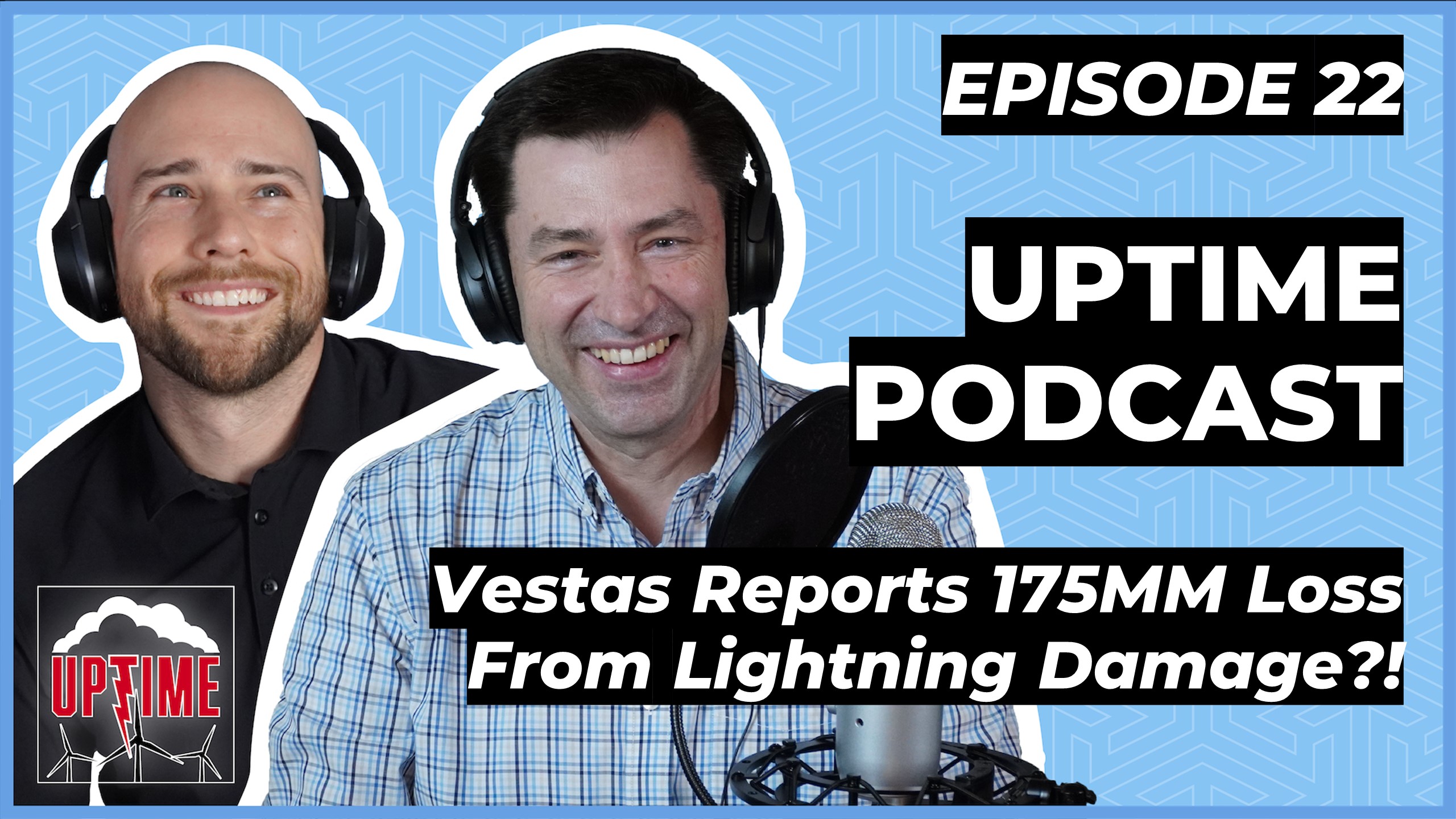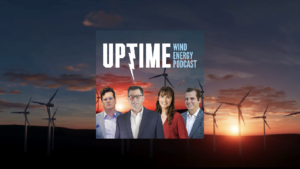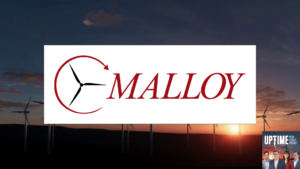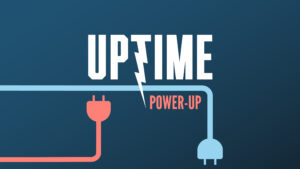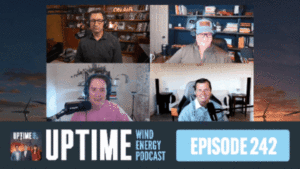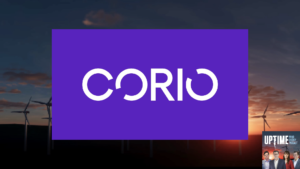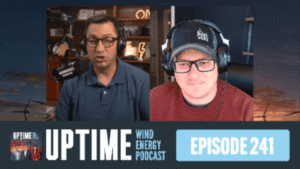Vestas had a rough quarter, reporting 175MM in losses from warranty claims due to high-intensity lightning strikes. It’s not clear what this means, but Allen and Dan dig in. Plus, more wind turbine customers are choosing to bring operations and maintenance in-house. Does this spell the beginning of the end for the profitable service contracts long enjoyed by turbine manufacturers?
Learn more about Weather Guard Lightning Tech’s StrikeTape Wind Turbine LPS retrofit. Follow the show on YouTube, Twitter, Linkedin and visit Weather Guard on the web. Have a question we can answer on the Uptime Wind Energy Podcast? Email us!
Podcast: Play in new window | Download
Full Transcript: Uptime Podcast EP22 – Vestas Wastes 175MM in Lightning-Related Warranty Claims, Plus – Are OEMs Out as Service Providers?
Dan: This episode is brought to you by Weather Guard Lightning Tech. At Weather Guard, we make wind turbine lightning protection easy. If you’re a wind farm operator, stop settling for damaged turbine blades and constant downtime. Get your uptime back with our Strike Tape lightning protection system. Learn more in today’s show notes or visit weatherguard wind.com/strike tape.
Allen: Welcome back. I’m Allen hall.
Dan: I’m Dan Blewett and this is the Uptime podcast where we talk about wind energy engineering, lightning protection, and ways to keep your wind turbines running.
In today’s episode, we’re gonna talk a bunch about lightning strikes. Uh, some articles, obviously it’s summertime. So there is electrical energy all over. Our marvelous planets. We’re going to talk a little bit about that.
Uh, Vestas has been having some lightening warranty issues. Obviously again, it is the summertime, so that’s not surprising, but they’ve reported $175 million loss because of additional warranty issues. So we’re going to chat through that. And then our second segment, as we talked about engineering, we’re going to talk a little bit more about, uh, O and M contracts and the idea that a lot of these wind turbine manufacturers are maybe going to lose.
Service contracts to their own customers who are potentially going to bring operates operations and maintenance in house to save money. So Allen hall is here with us, Alan, how are you doing
Allen: great, Dan boy, uh, this Vestus lightening issue was really surprising when it was announced. I haven’t seen any numbers, nearly the high in terms of lightning strikes for any particular OEM.
It wasn’t that just, it just seemed like off the charts, a massive amount of money.
Dan: That’s a lot of dough, 175 million.
Allen: Yeah. I can’t. They didn’t the one thing that was asked, but I don’t think answered was how many blades are we talking about and where, and that didn’t get answers. So that will trickle out over time.
I think if somebody is really on it, uh, but. In terms of financial numbers. Did you watch a Vesta stock with an after the announcement? It went up?
Dan: No, I don’t. Yeah.
Allen: Yeah, it did. It went up well. Okay. So they had a pretty good, I think if you just discount that one time, one time, $175 million, uh, loss, essentially our fee to fix the blades.
The rest of it was very positive and invest. This is in a really good position right now. I think that the just. Financially sound. They have cashflow, they got great products, positive things are happening there. But boy, talk about, we’ve never seen anything like that. I haven’t
Dan: well, well, well, I find the cyborg fascinating in its irrationality, which in my limited studies of it, and I should disclose, I, I own, um, Norwegian cruise line stock.
I bought a recently at a very, very steep discount. Mind you. Um, and I plan to keep it for a while. So I’m not concerned about its fluctuations. Uh, But I watched them, which is again, fascinating. They’re a good exam. So, uh, bought it around 15, a share and recently went down to 13. I’m like, eh, look, you know, and then when there was news, I woke up one morning, I look at the stock and it’s at 16.
I’m like, Oh, what happened? There must’ve been something important. Nope. This little notion of a Russian code vaccine coming out was enough to jump the stock from, you know, 25% in
Allen: one day.
Dan: No. And you’re like, literally there’s no cruise ships moving, nothing, nothing relevant business has been reporting except some speculation that there might be a vaccine, which is to be honest, like precisely the reason I bought it, the company is not going to go under in the next year.
They have tons of cash. They just raised. So like, as soon as there’s news, You know, that’s talking about like an actual vaccine, the talk, going to shoot up, probably sell it and whatever. But anyway, my point here is, is that when you look at these fluctuations in the stock market, They are not rationally tied to the business in many, many cases.
A lot of times they are obviously, but in many others, they’re not. So that doesn’t surprise me that with bad news of the stock here with Vestas, that is still maybe going the other way. Right.
Allen: Well, I think that. To, you know, there’s a lot of money floating around being pumped into economies right now, even though it does seem like a substantial number of smaller business owners are really struggling with all the COVID things that the particularly the power industry is one of those industries, is it.
Power is always needed. It seems like there’s cash inflow into those, into those as investments right now, just because of the stability of the electrical market is not going to go away relative to others, the kind of marketplaces like cruise lines. So, uh, I think that’s part of it. And, you know, Siemens can, Mesa has gone through some worry organizations recently, and they’re talking about reorganizing or splitting the wind turban suction off of the larger company.
It’s probably again another good move because it has value there, but you’re right. It doesn’t. With all the in theory, calamity of, of the economic conditions and COVID-19, and all the things that are happening in the world. The one thing that’s not fluctuating all that much is the overall stock markets.
And in any part of the world, we haven’t seen huge collapses, uh, which is either indicative of people, uh, taking a longterm view or people, uh, Just not participating one or the other. Uh, so, uh, I’m, I’m up up a little uptight about what’s gonna happen up and in the wind market, uh, at some point, is that going to turn around and go negative?
Don’t think so, but it just, things are just seem like there could go either way right now, which is really hard to swallow.
Dan: Yeah. Well, so let’s get back to the Vesta specifically. So what do you attribute this huge loss in warranty claims? Obviously they’re saying they’re having lightening issues. They’re not disclosing on what models on what blades they said it’s specific to some and not others.
Um, but you know, what is your speculation here about what this might be?
Allen: They describe it. It’s an interesting description. The way that it was talked about, because it said that the turbine blade issues related to. Quote unquote, high intensity lightening. So high intensity is either a high. Quantity like frequency or high amplitude, maybe a combination of both.
There’s only a couple of places in the world. What I would think there would be high intensity lightening, which would be Japan, Italy, uh, in some parts of the United States, Florida, for example, it could be high intensity lightening, but Florida doesn’t tend to have a lot of wind turbines. Surprisingly, uh,
Dan: no.
What amperages would you qualify? You being a lightening expert, would you say are high intensity?
Allen: The above a hundred thousand amps, I would say is getting to be large. And in Japan that’s relatively commonplace, but that tends to happen in the wintertime, not in the summertime. So that also makes me think, like something happened over the winter time, uh, in Japan.
And now we’re trying to correct it in the summertime when the weather’s good. It sounds like a Northern hemisphere problem. Uh, most likely it is, but they didn’t define it. Where in the world, it was that it was describe what the issue was or what the repair was for $175 million. You got to wonder if they’re replacing whole blades.
That’s what it screams to me that we’re replacing whole blades. That there’s something intrinsically off in the, in the production. I can’t imagine it. Well, it could be a design issue, but more likely it’s a production issue or a lifetime issue that popped up because that’s a huge number to swallow.
Dan: And what’s the typical cost to replace a whole blade?
Well, with the crane?
Allen: Well, it depends, right. It depends on how you’re going to get it down. It’s a lot of costs in the crane. You’re talking quarter million plus.
Dan: Yeah. And if it’s up in the, yeah, I love those videos where they’re carting a turbine blade up the mountains on the truck with the Dolly and they’re weaving in our air.
It’s fascinating. Yeah. And I’m sure it’s terrifying. Uh, on one of my other ones, podcasts, I had a, uh, A former baseball player who drove a, I can’t remember. He said he basically drove like one of the heaviest commercial trucks for a period when he worked in the oil industry and he, uh, he, so he, after he finished his pro baseball career, he was briefly working on, uh, like in like Texas on like, how do you just like quickly jumped into the industrial sector and was like pretty good, like pretty good at.
That whole line of work. So anyway, he got his commercial driver’s license and he said, he’s like, dude, this one day I was just driving this really heavy truck going down a really steep incline. And I was just sure, I was just gonna, like, we’re just gonna all die. Like, it was just terrifying, just this, this, this huge vehicle with his huge heavy equipment on it.
And like, I know what I’m doing, but he’s like, it’s just so, so treacherous sometimes. And to have that perspective was interesting because you think. No, you’re just driving, but I mean, these routes that these blades travel on up through the mountains, into the heavens. Yeah. It’s crazy. And it’s so precise and I mean, those guys are, I’m sure they have to like, Oh, we need bill.
We need wild bill to take this blade up here. Like they have, I’m sure they have their guys right. The special guy in aviation. Yeah. Well, like in the aviation industry, they have like those legendary test pilots, right? Yeah. They’re only going to call this guy for this crazy new plane, because he’s the guy that can rank wrangle it kind of thing.
I’m sure it’s the same way with some of these, these shipping jobs that just seem so intricate and difficult.
Allen: Oh yeah. I, uh, if they had to switch them, Plates. So there’s two problems, one getting the existing blade off and doing something with it. A lot of times just leave it on site. And then obviously getting, try to get a new blade up there that that’s a little, a little more difficult task.
Just the numbers don’t make any sense without that happening. If they’re going to call a bandaid, put a bandage on the, on a blade and try to improve the lightning protection, it should be nowhere near $175 million. That’s not really possible. So it’s something larger, something larger
Dan: things lurking. So let’s talk about this other article, um, coming out of Spain.
So just talking about the frequency of lightning strikes, which you’re well familiar with that every minute on the planet, 2000 lightning strikes are occurring all over the world. Um, you know, it’s the summer. And I know there’s a lot of, uh, obviously this is like high season for it, but there’s also a push to develop technology to be better at detecting these strikes.
But yeah, like you said, there’s no, there’s no force. That’s going like, Oh, we detected a strike. It’s just go ahead and push the button and stop it. Like nothing’s happening. Like, it’s just like, Oh, this is going to happen. So is lightning detection technology? Useful. Is it useless? Like where does, what are the pros and cons here?
Allen: I think it’s real functioning is to help locate where turbines have been struck and me to do some inspection on it without trying to look at every possible term. And every time there’s a thunderstorm running through. I think that’s why it has value. Uh, it can have value on, on the insurance side and say that damage to that blade was a lightening event, not a structural issue with the blade or the turbine itself.
Those kinds of insurance disputes can be, can provide data on and, and help us settle. Subtle arguments. But beyond that, I there’s just not a, I have a lot of added value there. Obviously, if you’re a technician, I think there’s a ton of value. So I don’t have to go look at a hundred turbines today. That’s awesome.
Awesome. Um, I’m going to look at three. That’s a lot better from a sort of a O and M and a site manager. I don’t know if it makes a huge amount of difference. That’s where I don’t see it has gained a lot of traction. I think, uh, what you’re seeing now is more, and I’ve got a couple of phone calls about this recently.
Uh, people are looking for. Information about each particular blades, like instrument each of the blades in the turbine. Eh, so they know exactly if a blade has been struck and to go look at that particular blade and have information about that strike, we’ll tell them a lot, a lot more information and it’s, it’s the way that the data systems are set up today.
Uh they’re there. Transmitting all that stuff to your cell phone. So, you know, immediately where to go. So let’s even a better look at it, but if you’re in a remote location, you can’t afford that kind of thing or your Terminus hadn’t been instrumented for it, then suddenly services can help.
Dan: Yeah. And that, that makes sense because I mean, this happens in all, especially in like the sports and fitness injury industry, where data is also, I mean, data is growing in every industry, right?
Like, Oh yeah. I’m sure the wind turbine industry is overrun with the amount of data. And this is happening even in, in like sports. I mean, baseball is a great example to bring it back up and you have to start to draw the line when it’s like, okay, we could track this, but then what are we going to do with this data?
Can we, do we fix something with it? If we don’t make something better and solve a problem, we don’t need the data. Like let’s not track it. If we can’t do something useful with it. And I’m sure there’s carry over here where, like you said, it does make sense to say, Hey, this blade got struck. We need to send someone out, but if you don’t have the capability to do that, like we don’t need to track it.
Like we don’t want to track everything. That’s not actionable. And if it’s not actionable, Let’s just let it be. We don’t need to overload. Cause then, I mean, you have people who are overwhelmed. Sure. Overrun and overwhelmed by all this data. It’s like, what do we do with it all, we have a million technicians, but they’re all doing real things.
And you just have a pile of data that doesn’t get isn’t useful. Isn’t useful. Doesn’t it? No
Allen: one looks at it. No one analyzes it. No one puts it into production, productive things.
Dan: all right. In our engineering segment here, let’s talk about a. Interesting new trend. That’s probably going to shape, uh, the industry for years to come. So this is out of the out of green tech media reporting by Jason Dane. So wind turbine makers is interesting headline they’re facing a growing threat to lucrative service deals, their own customers.
So service deals have been, you know, they’ve been making a lot of money for these companies, uh, for the turbine manufacturers themselves for a long time, doing the service deal continues to just like anything else. You’re a car manufacturer. You sell a warranty. You want people coming back in to sell parts, but now it seems like people who are buying these, the wind farm operators are saying, nah, we can do that in house.
We want to do that ourselves and save money and try to get parts themselves. So, uh, what’s your take on this, Alan?
Allen: I think the industry has a long way to go to figure this this out. Um, and the wind turbines are getting to be a size where we can’t play anymore. Uh, the, the, the, as we crossed the two megawatt threshold there, now we’re talking about 12 plus megawatt systems.
Uh, I understand the need to bring those service jobs back in house, because you can manage the inventory. You can manage the cost of particular components better. You can manage the labor a little bit better. Uh, you know, you’re not paying a quote unquote middleman. You’re not paying the part markup fees.
But there’s a consequence to that. And the consequences is that as a operator, do I know all the design details? And let’s just talk about the blades for a minute. Do I know that the design details on the structure of that blade? Like, do I know how many plies are fiberglass or in it, or how many carbon plies are in it and why they’re there and what happens if a and how to repair that properly?
I don’t know. When you start talking about complex carbon fiber, Uh, fiberglass structures as big and massive as these are. They’re not simple objects. So you either have to have a really good, fundamental understanding of how those things work and have somebody who’s knowledgeable how to fix them, or you need to re rely upon the OEMs.
Now there’s always a middle ground; I think there should be a compromise here, which has sort of been developed on in the aircraft where for a long time, which is you, can’t just Willy nilly put, uh, A car Potter on an airplane, even though that may be the main by the same company, uh, you can’t just to throw parts on an airplane.
And the reason for that is safety-related, because they found that substance, the parts didn’t work as well, or weren’t designed, or the person who installed the part didn’t realize that the part wasn’t designed to the same low rigor or same material strengths or, uh, performance as the aircraft part was.
Dan: Yeah. And how a bowl could look like a bowl to look like a nut does, but it’s not.
Allen: And helicopters has been a problem for a long time because, uh, the bolts are expensive because they’re high strength, then people would substitute or fake it. Uh, there’s a, there’s a fake market for a long time. There still is Bolton about it about once a month, about fake parts or Unauthorized parts being used. I think on the winter market, we’re kind of getting to that point of, there should be a listing of all the stuff that’s there and it’s appropriateness. And if someone wants to build a replacement part for that, you gotta be able to show that it meets the OEM standards. Now that gets hard because the OEMs don’t want to give that away.
So if I’m.
Dan: Yeah.
Allen: If I’m wind turbine company, a why would I want to tell this a small mom and pop operation? How do I make my part? Because they going to compete with me, but yeah, they’re going to compete with you. Anyway. The question is whether the part they’re going to use that the operator is going to use is appropriate for the wind turbines so that you don’t have a safety risk.
Those need to be balanced, I think, and on the aircraft world, uh, the FAA and the same thing in EASA, he also has even tighter restrictions and the Europeans are much harder restrictions than the Americans are, but you gotta have a, a sort of some fundamental approval process. Uh, it just can’t be all cost driven.
And we see that with our strike date product all the time, uh, that our Strike Tape product just delivers years and years and years of life. And there was some knockoffs out there that do not, and that they last for a couple of weeks. Uh, so, you know, wind turbine operators don’t really know the difference and there was no verification validation program.
So they’ll just pick whatever’s cheaper today and not realize that they’re putting the wind turbines, a very expensive thing, at risk. Because there’s no process. There’s just no process. There’s no regulatory and I’m not a big pusher for government regulation here. I don’t think it needs it, but there has to be some sort of industry regulation on what the heck’s going on and we just haven’t reached it yet.
So the pendulum swing, right. That was all in the OEM court. And I was kind of swinging the other way where it’s going to be in all the Indians and then suddenly operator’s court. And then it’s going to come back cause it’s going to go too far and we’re going to find that happy medium, but. It’s going to take awhile.
Dan: Yeah. Yeah. And you just hope that something catastrophic doesn’t happen to where, you know, like you said, like someone’s using the bolts from China or wherever. Right. And something really disastrous happens. And then everyone’s like, okay, now we need regulations. Like you hope it just like happens before that point.
But a lot of times that’s what, that’s what it takes. Right. I mean, that’s been the state of the aircraft industry, right. Mediation. They. I’ve had crashes throughout the years. And after every crash they get better. Yeah. So maybe it takes that kind of stuff to open eyes. A lot of times, as unfortunate as it is,
Allen: right?
If you’re the upper level management of a wind turbine OEM, you don’t want to be drug in front of your national government to explain yourself. Cause that’s what happens in most cases. And the aircraft side is that they’ll drag the head of Boeing out in front of them, in a congressional inquiry and give the company rep the third degree.
And it’s just bad PR all the way around. Right? So it forces, so companies like Boeing and Lockheed and you pick any of the aircraft companies around the world have realized like, Hey, there is a secondary market for parts. We don’t have to promote it. We don’t have to discourage it. We just want it to be safe and let it go
Dan: with that.
Well, and does the same thing need to happen for providers? I mean, a good example I think of is here in the U S if you start talking about. Like German automobiles, like, you know, my family had a Volkswagen when I was growing up. You couldn’t take a Volkswagen with like a turbo to just any auto mechanic.
Right. Because they just didn’t under like, they’re very technical. Um, and so you want to either I get to the Volkswagen dealership or to someone who specializes in like Volvos, Volkswagens Mercedes-Benz, whatever who were like, we we’re we’re really top notch it servicing these. You know, uh, German made cars.
So is there something like that that probably needs to happen as well? Where people have like, are I’m a certified provider or is that already there?
Allen: Uh, there, it isn’t, it isn’t in a sense, uh, It’s kind of half halfway there just because industry is still relatively young. I think that’s the issue. Um, as it grows up and the, and the financial risks get higher, it starts to get smarter as it tries to minimize downside risk.
And that’s one thing that’ll happen. It’ll start to. Provide standards and start to force itself to be better. Um, there’s a sort of an equivalent in the, in the aviation world, which is the airlines tend to have their own, um, ability to pair their own aircraft or to make modifications to them and record them to justify those.
Decisions, but they have an engineering staff there that does that. Now you gotta be able to afford that if I’m, if I’m a wind turbine operator, if I’m an Ebola, I probably have enough engineers to do that. Uh, just because I’m a large corporation and I have resources to do that. If I’m, if I am operating a hundred wind turbines in the middle of South Dakota, I probably don’t have the ability to have five engineers on staff all the time.
Take care of that stuff.
Dan: Yeah.
Allen: In, in the United States, on the aviation market, the smaller airlines have had trouble. Same reason. That same sort of reason just don’t have the resources. So there is a parts of scale here that matter where you have to have enough money to support the engineering.
Dan: All right.
Well, we’re going to wrap up today’s episode. So to have uptime, if you’re new to the show, welcome. If you’re a regular here, thank you for your continued support. Please subscribe to the show and leave a review on iTunes, Spotify, or wherever you listen to podcasts. Don’t forget to check out the Weather Guard Lightening Tech YouTube channel for video episodes.
Full interviews and short clips from each show for Allen and all of us at Weather Guard stay safe and we’ll see you next week.
Is downtime causing you financial pain and putting a stop to your power production for months on end. It’s no secret lightning strike damage is a major cause of wind turbine downtime. This damage is preventable with our easy to install strike table lightning protection system for wind turbine blades are incredible engineering, build quality materials and edge sealants withstand up to five times more abused in the toughest weather, enlightening conditions.
And we’ve got the research to prove it. If you’re tired of constant downtime, we can help reach out to us at weather guardwind.com and schedule a free call. We’ll get your uptime back in no time.



